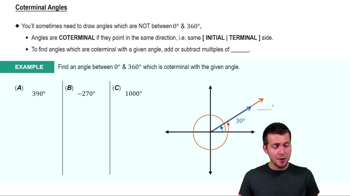Table of contents
- 0. Review of College Algebra4h 43m
- 1. Measuring Angles39m
- 2. Trigonometric Functions on Right Triangles2h 5m
- 3. Unit Circle1h 19m
- 4. Graphing Trigonometric Functions1h 19m
- 5. Inverse Trigonometric Functions and Basic Trigonometric Equations1h 41m
- 6. Trigonometric Identities and More Equations2h 34m
- 7. Non-Right Triangles1h 38m
- 8. Vectors2h 25m
- 9. Polar Equations2h 5m
- 10. Parametric Equations1h 6m
- 11. Graphing Complex Numbers1h 7m
1. Measuring Angles
Complementary and Supplementary Angles
Problem 3.90
Textbook Question
Give an expression that generates all angles coterminal with an angle of π/2 radians. Let n represent any integer.
 Verified step by step guidance
Verified step by step guidance1
Understand that coterminal angles are angles that share the same terminal side when drawn in standard position.
Recognize that to find coterminal angles, you can add or subtract full rotations (in radians, a full rotation is \(2\pi\)).
Given the angle \(\frac{\pi}{2}\), you can generate coterminal angles by adding or subtracting \(2\pi\) multiplied by any integer \(n\).
Write the expression for coterminal angles as \(\frac{\pi}{2} + 2\pi n\), where \(n\) is any integer.
This expression accounts for all angles that are coterminal with \(\frac{\pi}{2}\) by varying \(n\).
Recommended similar problem, with video answer:
 Verified Solution
Verified SolutionThis video solution was recommended by our tutors as helpful for the problem above
Video duration:
0m:0sPlay a video:
Was this helpful?
Key Concepts
Here are the essential concepts you must grasp in order to answer the question correctly.
Coterminal Angles
Coterminal angles are angles that share the same terminal side when drawn in standard position. They can be found by adding or subtracting full rotations, which in radians is equivalent to adding or subtracting multiples of 2π. For example, an angle of π/2 radians is coterminal with angles like π/2 + 2πn, where n is any integer.
Recommended video:

Coterminal Angles
Radians
Radians are a unit of angular measure used in mathematics, particularly in trigonometry. One radian is defined as the angle subtended at the center of a circle by an arc whose length is equal to the radius of the circle. This unit is essential for understanding angles in terms of circular motion and is often preferred in calculus and higher mathematics.
Recommended video:

Converting between Degrees & Radians
Integer Representation
In the context of generating coterminal angles, 'n' represents any integer, which can be positive, negative, or zero. This allows for the expression of an infinite number of angles that are coterminal with a given angle. The use of integers is crucial for indicating that the angles can be derived from the original angle by adding or subtracting full rotations.
Recommended video:

Introduction to Common Polar Equations

 3:35m
3:35mWatch next
Master Intro to Complementary & Supplementary Angles with a bite sized video explanation from Patrick Ford
Start learningRelated Videos
Related Practice








